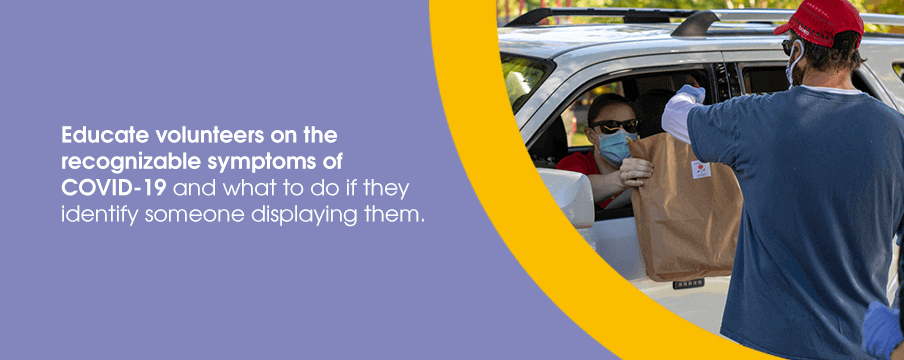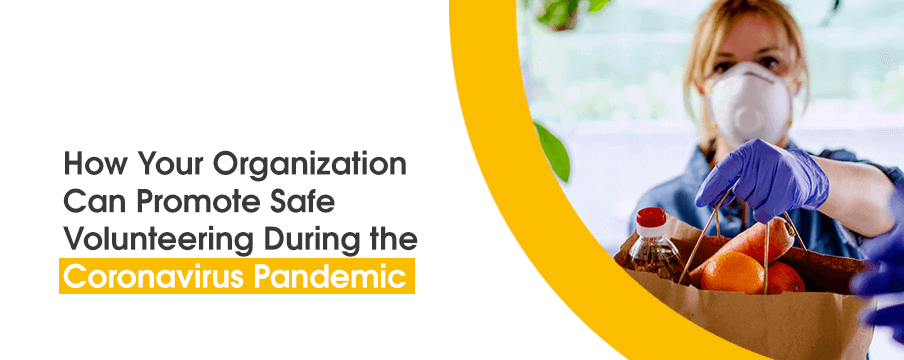COVID-19 changed the way we do a lot of things, including volunteering. Help is now more necessary than ever across all organizations — in animal shelters, food banks, child care, hospitals, and more — and people are eager to assist their community.
As a compassionate volunteer organization, your priorities likely shifted to keeping your volunteers and community members safe amid these challenging times. Considering the Centers for Disease Control and Prevention’s (CDC) guidelines and other safe volunteering best practices during the pandemic, you can implement the following safety measures to prevent the coronavirus’ spread while supporting your community.
The 8 Best Safety Measures for Volunteer Organizations During the COVID-19 Pandemic
Most volunteer organizations witnessed a shift in routine operations following the coronavirus outbreak. If you’re looking for the best volunteering safety measures for your volunteers and community members, consider the following.
1. Follow CDC Guidelines and Recommendations
The CDC is a highly reputable source for COVID-19 prevention guidelines. For group gatherings, the CDC recommends volunteers, community members, and organizations take the following precautions.
- Cover your nose and mouth. Keep face masks on hand in case a volunteer or community member forgets theirs.
- Encourage volunteers to bring bottled water or a canteen from home.
- Practice social distancing with a 6-foot minimum separation.
- Establish routes to regulate traffic flow to promote social distancing.
- Limit the number of people who can use the restroom at one time.
- Post informational signage on how to prevent the spread of COVID-19.
- Complement signs with announcements encouraging people to stay informed.
- Ensure proper ventilation inside buildings. Whenever possible, hold volunteer services outdoors.
- If necessary, create a physical boundary between volunteers and community members.
- When serving food, opt for individual boxes or bags instead of a buffet or family-style meal.
For more information on CDC’s evolving guidelines and recommendations during the coronavirus pandemic, visit their website and read their community-based organization considerations.
2. Set up Hand-Washing Stations
The CDC and other public health officials have told us coronavirus spreads via respiratory droplets, while other research suggests it is an airborne disease. Both reinforce the importance of frequent handwashing, especially when serving the community.
Set up hand-washing stations around your volunteer service area, and instruct volunteers on the importance of handwashing. Set up these stations where you can monitor adherence to these recommendations. We suggest posting informational signage near these stations to reinforce the proper hand-washing guidelines of using soap and water and washing for at least 20 seconds.
If hand-washing stations aren’t available for your volunteer service, provide hand sanitizer that contains at least 60% alcohol for adequate sanitization.
3. Disinfect Surfaces Frequently
Respiratory droplets from coughing, sneezing, talking, and singing can transfer to people’s hands and rest directly on surfaces. So, it’s essential to practice continual disinfecting procedures to limit the coronavirus’ spread.
Keep the right cleaners and disinfectants on hand, including:
- Soap.
- Water.
- Sanitizer.
- Paper towels.
- Tissues.
- Disinfectant wipes.
- No-touch trash cans.
Practice safe and correct disinfecting procedures. Make sure to clean frequently touched surfaces like door handles, sink handles, hand railings, writing utensils, etc. It may benefit your organization to institute a cleaning schedule and procedure for volunteers to follow.
4. Train Staff and Volunteers to Recognize COVID-19 Symptoms
Ask your volunteers to arrive early to allow time for training and COVID-19 screenings. Take this time to communicate your expectations. Educate volunteers on the recognizable symptoms of COVID-19 and what to do if they identify someone displaying them.

The recognizable COVID-19 symptoms, as listed by the CDC, include:
- Dry cough.
- Shortness of breath.
- Fever.
- Loss of taste or smell.
- Congestion or runny nose.
- Headache.
- Body or muscle aches.
- Fatigue.
- Sore throat.
For additional health and safety, screen community members before providing personalized aid. If they’re showing any of these symptoms, encourage them to go home and contact their health care provider. Or, if symptoms are severe, instruct them on where they can reach the nearest emergency room or call emergency response services.
5. Schedule Volunteers in Different Shifts
Consider scheduling your volunteers in strategized shifts to limit each small group’s exposure to the coronavirus and maintain social distancing practices. Or, if you can, consider moving volunteer opportunities online, where people can contribute virtually.
Volunteer management software can simplify the process of strategizing your shifts. Communication is crucial, so opt for a management software where volunteers can log in and quickly identify their shift to avoid confusion.
6. Move Volunteering Online
Safe volunteer operations during the COVID-19 pandemic entails creating volunteering opportunities people can perform from the comfort — and safety — of their homes.
If you know some of your volunteers are high-risk or prefer volunteering from home, update their profile on your volunteer management system to reflect that preference for future scheduling use.
7. Log Hours for Contact Tracing
When scheduling, record each volunteer’s personalized information, such as their:
- First and last name.
- Phone number.
- Email address.
Use this information to identify and track a volunteer’s shift if the coronavirus spreads throughout the volunteer group or location. Again, it may be beneficial to use volunteer management software for easier identification in an emergency or schedule disruption.
8. Keep Volunteers Informed via Email and Text Alerts
Volunteering during the COVID-19 is just as novel to your volunteers as it is to you. Keep your volunteers abreast of any routine procedure changes or last-minute updates via email and text alerts.
You can send updates through a volunteer management tool. Referencing a piece of paper or manually reaching each volunteer costs valuable time, but the right volunteer management tool allows you to contact a group of volunteers with ease when required.

Keep Your Volunteers Safe Using Volgistics’ Volunteer Management Software
Volgistics — we set the standards in volunteer management software. Our confidence derives from our powerful software, designed to keep up with the changing procedures surrounding the coronavirus pandemic.
Our software makes it easy to manage your volunteer organization’s operations, thanks to our impressive core features, such as:
- Volunteer recruiting and application forms.
- Volunteer tracking and reporting
- Volunteer scheduling and self-scheduling.
- Online volunteer portal.
- On-site sign-in kiosk.
- Multi-site capabilities.
- Text and email functions.
- Document storage.
We pride ourselves on our versatile volunteer management platform and our outstanding customer service. Our support team has specialized training to work with you and answer your unique questions and needs. When you have a question, you can rely on us to be there for fast and free support.
Visit Volgistics online for a free trial of our platform. Or, contact us online, and one of our representatives will promptly get you started on the track to ultimate volunteer management.

